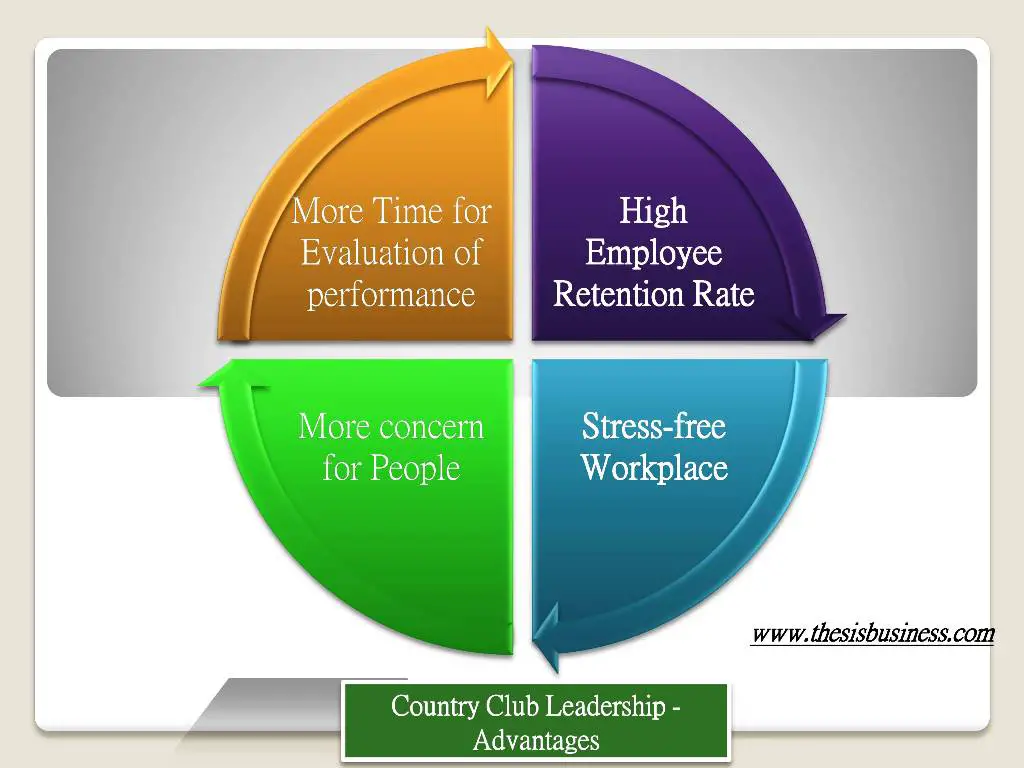By nomenclature, a country club does not sound like an office but rather a club. It is a management style where concern for people is emphasized more than concern for production. In addition, there also works a belief that maintaining the workers happy would increase output.
In this article, a detailed view of this type of management style has been explained.
Table of Contents
Country Club Leadership –
According to Blake and Mouton’s Managerial Grid, the country club management style has the least concern for production and more concern for people among other management or leadership models. Nevertheless, the growth of the company or the farm might be compromised by this type of leadership because of emphasizing workers’ concerns. However, some companies might also have fruitful results from such leadership styles.
Background –
Country club leadership has a long history back of its implementation. In the late 1960s, Robert Blake and Jane Mouton developed a graphical framework for various leadership attitudes. The grid consists of five control methods based on two different leadership behaviour: care for people and concern for production.
Concern for people entails giving employees and other human stakeholders the attention, care, and well-being they deserve. Care for output, outcomes, and other non-human things are part of the concern for production. These two things are typically different and have opposite goals too.
In the meantime, the grid differs the leadership styles based on the emphasis of these two aspects. Along with Country Club Management, the other four leadership philosophies in the Blake and Mouton Managerial Grid are Impoverished Management, Authority-Compliance Management, Middle-of-the-Road Management, and Team Management.
Country Club Leadership – Example
It is challenging to provide real-life examples, whereas in the case of Tata Motors, having faced an issue strike by the Labour Union. Here, the organization has already increased bonuses that have yet to satisfy their labourers.
However, labourers are called for a strike. In such circumstances, the director of Tata Industries, Mr Ratan Tata, joined them and asked the dignitaries to increase the bonus. Such a kind gesture from Mr Tata touched workers. They stated that Mr Tata joined us in this strike, but the organization’s procedures prevented the company from increasing bonuses. It is enough to have a leader like Mr Tata. Later 21on, workers called off their strikes because they believed what Mr Tata did to them was remarkable.
However, country club leadership is to make workers happy, whereas Mr Tata did the same. Leaders must recognize and monitor their country club leaders, just like they did with impoverished leaders.
Under Country Club leadership, specific individuals are likely to behave in this manner, which is a relatively simple sign of being a great leader. However, it is to be remembered that very poor or non-existent performance is a more overt sign of developing country club administration. Anyone who doesn’t see this poor performance right away has to examine their standards and ask themselves why.
People frequently assert that motivated employees work more, yet there might be a distinction. While it is possible for hard workers also to be happy employees and vice versa, there is no inescapable link between the two.
Country Club Leadership – Advantages & Disadvantages

Country Club Leadership has several benefits:
- High staff retention is the outcome of strong people focuses.
- Most people experience a stress-free workplace because of low expectations for performance.
- For the employees, work-life balance is perfectly managed because of more significant concerns for people than other management styles.
- Due to a stress-free workplace, employees get more time to evaluate themselves and grow more in their respective sections.
The Country Club Leadership’s drawbacks include:
- Low or absent performance and production are the results.
- Performance issues will make jobs less secure, which is counter to putting the needs of the people first.
- Due to having no professional target to close, employees become a bit lazy, affecting their productivity.
- Moreover, country club management lacks professionalism and seriousness among the employees, which makes them less productive.
- Last but not least, the country club management style can end someone’s business eventually because of the aforementioned drawbacks.
People should steer clear of country club leadership since it might impact their jobs. Instead, the company should recommend contemporary employment and adaptable leadership techniques based on emotional intelligence. Country clubs’ genuine managers should refrain from using this management approach. If a country club director operated in this manner, the staff wouldn’t be motivated to put in the necessary effort to look after club members and guests, which would rapidly result in a loss of clients, leaving the staff without a job.
Implementation –
An exhausted and overworked nursing staff needs health and wellness, and several policies and research papers advocate for leadership to create these conditions. Rarely do they offer advice on how to practice leadership or consider if certain leadership styles can have unfavourable effects.
Employers also point out that the need for guest job satisfaction and worker recruiting are factors in the growth of training’s significance in the hospitality sector. Establishing a leadership development training program for hospitality is essential to building human capital inside the firm since labour force concerns affect the viability of hospitality organizations.
The priorities of a country club leader are so heavily centred on people, relationships, harmony, etc., that performance is given relatively brief consideration. Two additional factors would maintain performance levels: their team would be aware of the performance expectations from layers above and below them, and specific team members would have strong work ethics.
These variables worked together to produce Middle-of-the-Road Management rather than authentic Country Club leadership, allowing the managers to continue having low-performance expectations for a long time. Despite some apparent lack of performance and terrible behaviour, no one would ever be dismissed or even punished, regardless of what was happening or what the team members were doing.
Conclusion –
Because of their outstanding people management abilities, the leaders might have created something much better and stronger if they had been more performance-focused. Unless they are in charge of a social club where the emphasis is on relaxation rather than performance, people should refrain from becoming country club presidents.
We recommend that a country club leader employ a more contemporary set of leadership styles instead; one example is the six leadership styles by Goleman, which are incredibly adaptable and helpful in all circumstances. Essential articles on Blake and Mouton’s Managerial Grid, Impoverished Management, and Produce-or-Perish Management, also known as Authority-Obedience Management, may teach them more about the complete framework as well as the other styles.
References
Cichy, R.F., Knutson, B.J. and Cha, J., 2004. The five essentials of private club leadership. Hospitality review, 22(2), p.5.
Cummings, G.G., MacGregor, T., Davey, M., Lee, H., Wong, C.A., Lo, E., Muise, M. and Stafford, E., 2010. Leadership styles and outcome patterns for the nursing workforce and work environment: a systematic review. International journal of nursing studies, 47(3), pp.363-385.
Davis, C.L., 2016. More than just a rich country club: membership conditionality and institutional reform in the OECD. Scholars at Harvard, June 26, p.2016.
Einarsen, S., Aasland, M.S. and Skogstad, A., 2007. Destructive leadership behaviour: A definition and conceptual model. The leadership quarterly, 18(3), pp.207-216.
Garg, S. and Jain, S., 2013. Mapping leadership styles of public and private sector leaders using Blake and Mouton leadership model. Drishtikon: A Management Journal, 4(1), p.48.
Goleman, D., 2017. Leadership that gets results. In Leadership Perspectives (pp. 85-96). Routledge.
Hackman, M.Z. and Johnson, C.E., 2013. Leadership: A communication perspective. Waveland press.
Ho, J., 2012. Creating a hospitality leadership development training program for a country club.
Jackson, A.W., 1897. A country club (Bachelor’s thesis, Massachusetts Institute of Technology, Dept. of Architecture).
Mayo, J.M., 1998. The American country club: an evolving elite landscape. Journal of Architectural and Planning Research, pp.24-44.
